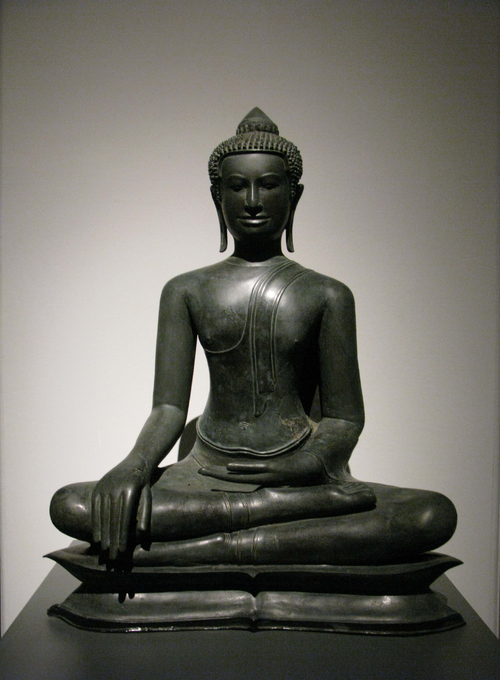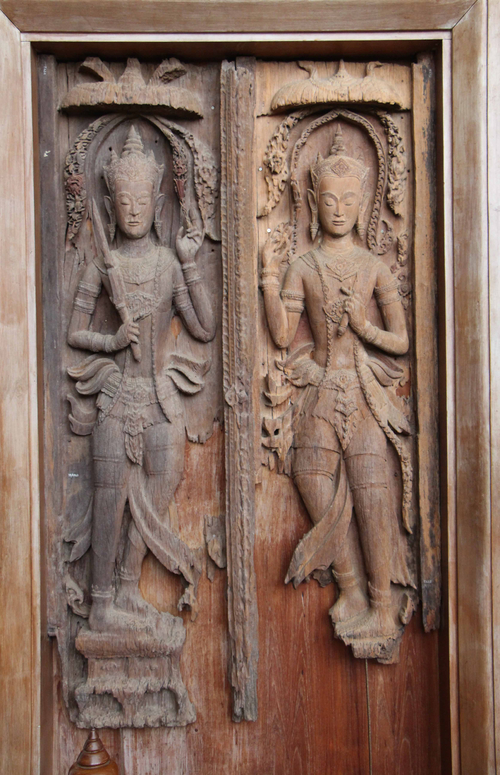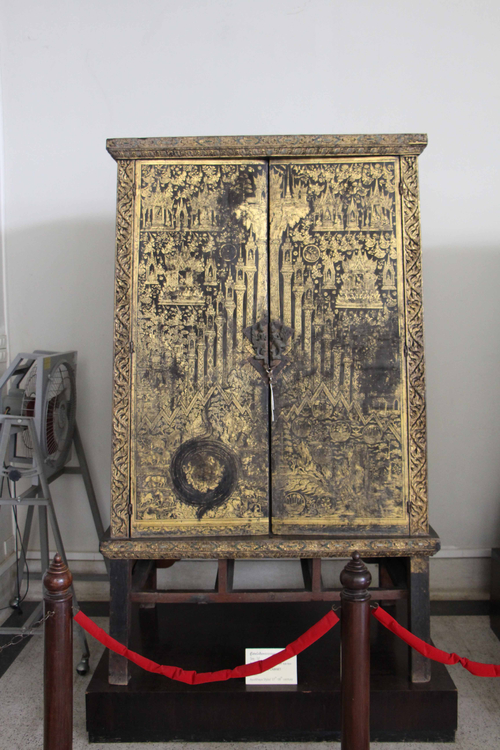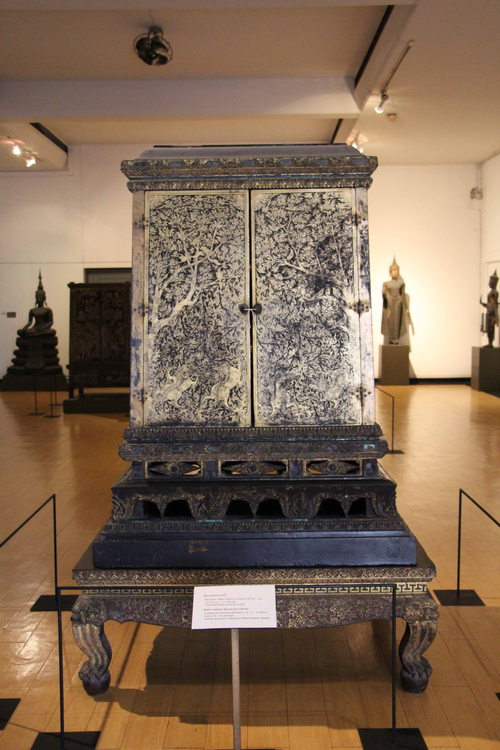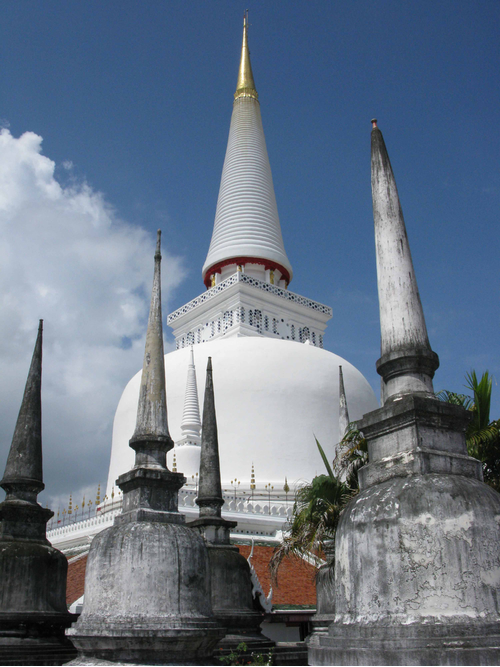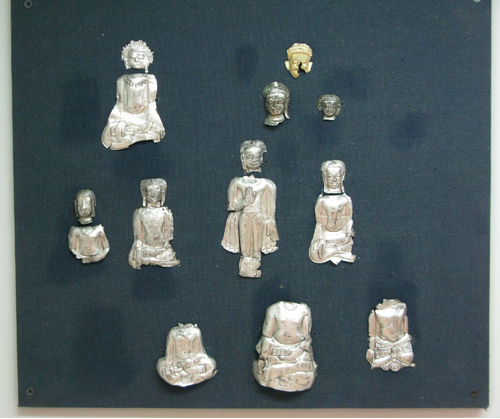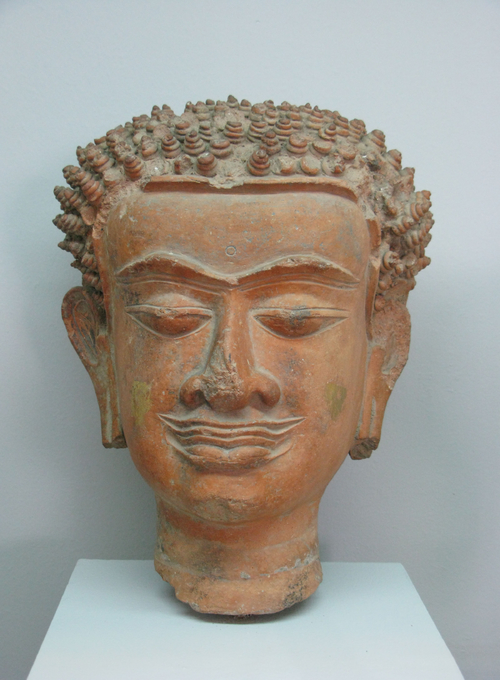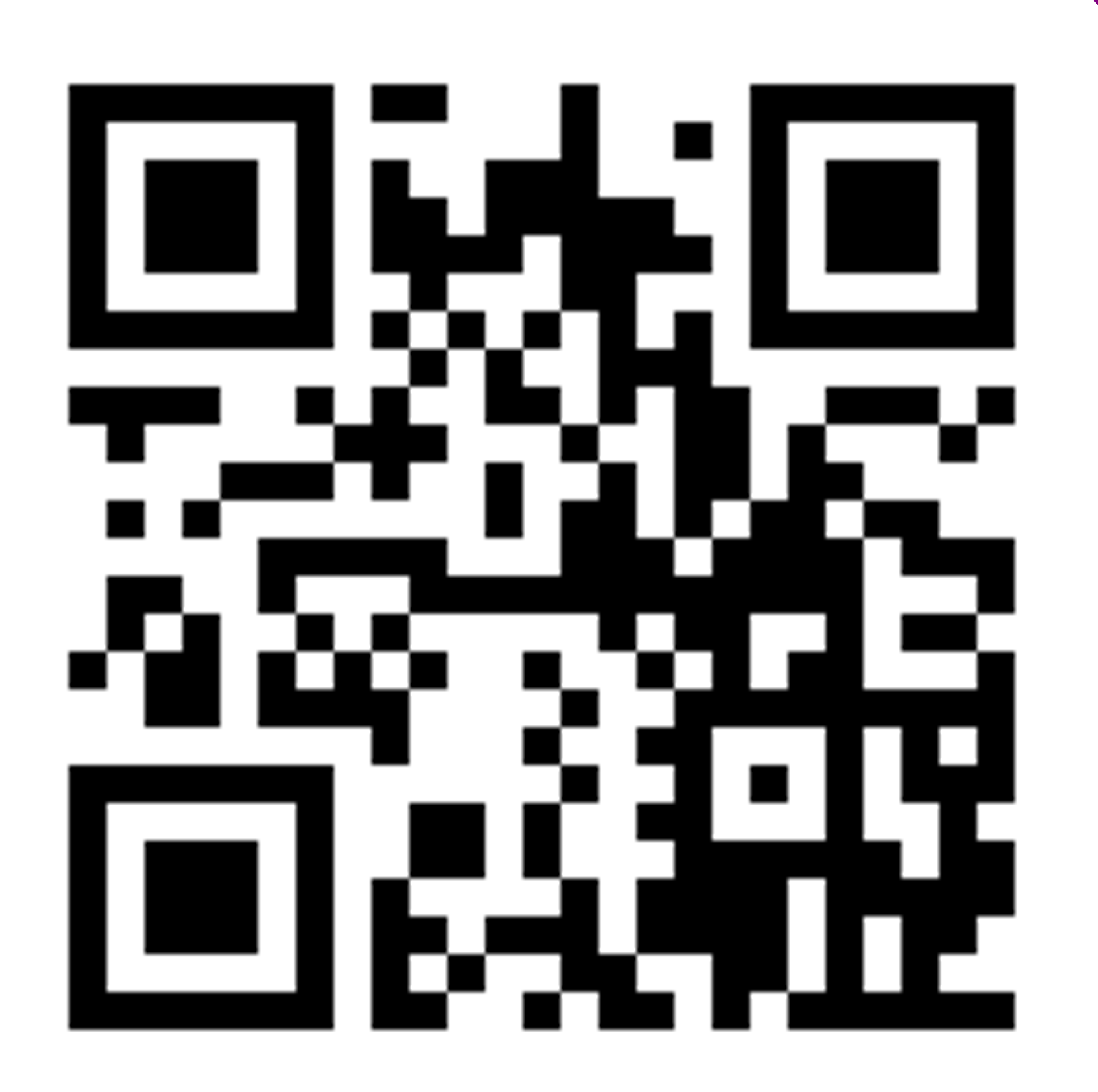ค้นหางานศิลปกรรม
ฐานข้อมูลศิลปกรรมในเอเชียตะวันออกเฉียงใต้
ประติมากรรมพระพุทธรูปปางมารวิชัย
พระพุทธรูปอยู่ในอิริยาบถนั่งขัดสมาธิราบปางมารวิชัยอยู่บนฐานบัวเกลี้ยงไม่ประดับลายสุนทรียภาพที่สัมพันธ์กับศิลปะเขมรในประเทศไทยแบบบายนหรือหลังบายน ได้แก่ พระพักตร์เหลี่ยม ไรพระศกเป็นแถบเหนือพระนลาฏ หยักเป็นมุมแหลมบริเวณพระกรรเจียก (ขมับ) พระอุษณีษะทรงกรวยแหลมรองรับด้วยแถวกลีบบัว พระพุทธรูปองค์นี้ครองจีวรห่มเฉียง โดยเส้นชายจีวรที่พาดผ่านพระอุระขวาตวัดเป็นเส้นโค้งอาจสัมพันธ์กับศิลปะอินเดียแบบปาละไม่มากก็น้อย ชายสังฆาฏิหรือชายจีวรพาดผ่านพระอังสาซ้ายยาวจรดพระนาภี พระหัตถ์ขวาวางอยู่บริเวณพระชงฆ์ แลดูใหญ่และเทอะทะ เป็นลักษณะหนึ่งของพระพุทธรูปยุคก่อนกรุงศรีอยุธยา
ประติมากรรมบานประตูไม้
บานประตูไม้คู่นี้สลักภาพทวารบาลบานละ 1 องค์ รูปแบบเป็นแบบเดียวกันต่างกันเพียงอิริยาบถที่สลับข้างกัน ทั้งคู่ยืนในอิริยาบถพักขาบนฐานสิงห์ พระหัตถ์ข้างหนึ่งยกขึ้นกำช่อดอกไม้ พระหัตถ์อีกข้างหนึ่งถือพระขรรค์พระพักตร์ยาวรี สวมเครื่องทรงหลายอย่าง เช่น มงกุฎที่ประกอบด้วยกระบังหน้าและรัดเกล้ากรวย มียอดแหลมขนาดเล็กล้อมรัดเกล้า กุณฑลทรงตุ้มแหลม กรองศอ สังวาล ทับทรวง พาหุรัด ทองพระกร เข็มขัดรัดพระองค์ ทองพระบาท สวมผ้านุ่งสั้นแต่มีชายผ้ายาว พระเศียรมีซุ้มล้อมรอบทำนองเดียวกันกับประภามณฑล ถัดออกไปเป็นช่อดอกไม้ ถัดขึ้นไปเป็นฉัตร
จิตรกรรมตู้พระธรรม
ตู้พระธรรมใบนี้ทำขาตู้ด้วยไม้สี่เหลี่ยมธรรมดา ไม่สลักลวดลายใดๆ นิยมเรียกขาตู้แบบนี้ว่าขาหมู จึงนำไปใช้เรียกตู้แบบนี้ว่า ตู้พระธรรมขาหมูฝาตู้มีลายลดน้ำ หรือลายลงรักปิดทอง เขียนภาพภูมิจักรวาลในคติพุทธศาสนา ภาพนี้แบ่งเป็น 2 ส่วน โดยมีเส้นสินเทาคั่นแบ่งระหว่างกัน เบื้องล่างของเส้นสินเทาแสดงภาพป่าหิมพานต์อันเป็นป่าที่ชมพูทวีป บานทางซ้ายมือปรากฏภาพสระอโนดาต เป็นสระน้ำรูปวงกลมขนาดใหญ่ซึ่งเป็นต้นกำเนิดของแม่น้ำ 4 สาย แม่น้ำแต่ละสายไหลออกมาจากปรากของสัตว์แต่ละชนิด ได้แก่ ช้าง ม้า วัว สิงห์ ส่วนบานทางขวามือเป็นภาพสระน้ำอื่นๆ ในป่าหิมพานต์ แสดงเป็นรูปสระน้ำวงกลมขนาดเล็กที่มีดอกไม้หรือดอกบัวอยู่ภายใน องค์ประกอบส่วนอื่นมีต้นไม้ โขดหิน และสัตว์ต่างๆ ด้านบนของเส้นสินเทาแสดงภาพเขาพระสุเมรุอยู่ตรงกลาง บนยอดเป็นสวรรค์ชั้นดาวดึงส์ที่อยู่ของพระอินทร์ มีปราสาทซึ่งคงหมายถึงปราสาทไพชยนต์อยู่ตรงกลาง ช้างอเราวัณอยู่ด้านล่างราวกับว่าแบกปราสาทนี้ไว้ จุฬามณีเจดีย์อยู่ทางขวามือ ถัดลงมาทั้ง 2 ข้างจากเขาพระสุเมรุเป็นเขาสัตตบริภัณฑ์ หรือเขาวงแหวนเจ็ดชั้นที่ล้อมรอบเขาพระสุเมรุ แต่ละลูกมีความสูงลดหลั่นกันลงไป แสดงอออกในรูปทรงแท่งเสาจำนวนด้านละ 7 แท่ง แสดงให้เห็นว่าช่างได้วาดภาพเขาสัตตบริภัณฑ์ด้วยมุมมองผ่าแบ่งครึ่ง เหนือเขาแต่ละลูกมีวิมานของเทวดา แวดล้อมเขาพระสุเมรุและเขาวงแหวน 7 ชั้น ยังปรากฏภาพวิมานเทวดาและเหล่าเทวดาในท่าเหาะจำนวนมาก มีวงกลม 2 วงที่แทนพระอาทิตย์และพระจันทร์ด้วย
จิตรกรรมตู้พระธรรม
เป็นตู้พระธรรมตกแต่งด้วยลายรดน้ำ ตอนบนเป็นภาพต้นไม้ใหญ่แผ่กิ่งก้านสาขาจากริมตู้ มีดอกและใบเต็มพื้นที่ ตอนล่างเขียนลายกระหนกเปลว ครุฑคาบ นาคคาบ ออกเถาหัวนาค เคล้าภาพสัตว์ นก กระรอก แมลง และสัตว์ป่านานาชนิดรวมทั้งสัตว์หิมพานต์ภาพตอนบนและตอนล่างแม้จะมีองค์ประกอบที่แตกต่างกัน แต่มิได้ลดทอนความงดงามและกลมกลืนลงไป ความอ่อนช้อยของลายกระหนกกับความแข็งกระด้างของลำต้นและกิ่งไม้ ซึ่งมีดอกและใบแผ่ขยายอยู่เกือบเต็มพื้นที่ แต่ก็ปรากฏภาพสัตว์ต่างๆ แทรกอยู่อย่างกลมกลืน ด้วยท่าทางที่เป็นธรรมชาติดูมีชีวิตชีวา เป็นความงามประการหนึ่งที่สอดคล้องกับความอ่อนช้อยของลายกระหนกเปลว แสดงให้เห็นถึงความคิดอิสระของศิลปินในสมัยนั้นที่สามารถใช้จินตนาการของตนสร้างงานขึ้นโดยไม่กระทบกระเทือนถึงระเบียบแบบแผนหรือกฎเกณฑ์ของธรรมชาติ
สถาปัตยกรรมพระบรมธาตุนครศรีธรรมราช
รูปแบบปัจจุบันจากส่วนฐานจนกระทั่งส่วนยอดของพระบรมธาตุเจดีย์นครศรีธรรมราชมีลักษณะดังต่อไปนี้ส่วนล่างเป็นฐานประทักษิณสูง ล้อมรอบด้วยระเบียงหรือที่เรียกว่าวิหารทับเกษตร บันไดทางขึ้นสู่ลานประทักษิณอยู่ทางทิศเหนือซึ่งเป็นด้านที่เชื่อมต่อกับวิหารพระทรงม้า ทำให้บันไดทางขึ้นสู่ลานประทักษิณตั้งอยู่ภายในวิหารพระทรงม้าไปโดยปริยายผนังของฐานประทักษิณประดับด้วยแนวเสาอิง บนตัวเสาอิงมีพระพุทธรูปยืนขนาบบ้างด้วยพระสาวกอยู่ภายในซุ้ม ระหว่างเสามีช้างเห็นครึ่งตัวอยู่ภายในซุ้มวงโค้งหรือซุ้มหน้านางด้านละ 6 ตัว ยกเว้นทางด้านเหนือมีอยู่ 4 ตัว เพราะต้องเว้นพื้นที่ไว้สำหรับบันไดทางขึ้นสู่ลานประทักษิณ บนลานประทักษิณมีเจดีย์ทรงกลมขนาดใหญ่ตั้งอยู่ตรงกลาง ที่มุมทั้งสี่มีเจดีย์ทรงกลมประจำมุม เจดีย์องค์ใหญ่เป็นหัวใจสำคัญที่สุดมีองค์ระฆังกลมขนาดใหญ่ เหนือองค์ระฆังเป็นบัลลังก์สี่เหลี่ยมขนาดใหญ่ ประดับด้วยปูนปั้นรูปเสาอิงและเครื่องถ้วย ถัดขึ้นไปเป็นก้านฉัตรหรือแกนปล้องไฉนซึ่งประดับด้วยเสาหานที่มีรูปพระอัครสาวกตกแต่งอยู่ เรียกกันทั่วไปว่า พระเวียน ถัดขึ้นไปเป็นปล้องไฉน ปัทมบาทและปลีซึ่งหุ้มด้วยทองคำและประดับด้วยอัญมณีมีค่า
ประติมากรรมพระพุทธรูป
แผ่นเงินดุนนูนพระพุทธรูปกลุ่มนี้ล้วนอยู่ไหนสภาพชำรุดมากบ้างน้อยบ้างต่างกันไป บ้างเหลือแต่พระเศียร บ้างเหลือแต่พระวรกาย มีทั้งพระพุทธรูปยืนและพระพุทธรูปนั่ง รูปแบบโดยรวมแสดงให้เห็นถึงความเป็นศิลปะหริภุญชัย ขณะเดียวกันก็แสดงความเกี่ยวข้องกับศิลปะพม่าสมัยพุกามด้วย เช่น การทำพระพุทธรูปสวมมงกุฏทรงเทริดขนนก การนั่งขัดสมาธิเพชร
ประติมากรรมเศียรพระพุทธรูป
เศียรพระพุทธรูปองค์นี้มีรูปพระพักตร์ค่อนข้างยาว รูปแบบอันเป็นเอกลักษณ์ของประติมากรรมดินเผาศิลปะหริภุญชัย ได้แก่ พระขนงต่อเป็นปีกกาและเป็นสันนูน พระเนตรโปน เปลือกพระเนตรหลี่ลงต่ำเพียงครึ่งหนึ่ง พระนาสิกบาน พระโอษฐ์แบะ มีพระมัสสุ (หนวด) มีการร่องเพื่อเน้นเส้นขอบตามส่วนต่างๆ ที่กล่าวถึงข้างต้น มีพระอุณาโลมกลางพระนลาฏ พระเกศาขมวดเป็นวงก้นหอย มีไรพระศกเป็นแถบนูน
ประติมากรรมพระพุทธรูป
พระพุทธรูปสำริดองค์นี้ชำรุดมาก พบไม่ครบทุกส่วน โดยพบเพียงพระเศียร พระวรกายช่วงบน พระหัตถ์ และพระบาท ลักษณะเด่นของพระพุทธรูปองค์นี้ที่แสดงความเกี่ยวข้องกับศิลปะก่อนกรุงศรีอยุธยาหรืออู่ทองทางภาคกลาง ได้แก่ พระพักตร์สี่เหลี่ยม ในขณะที่ส่วนอื่นๆ แสดงการสืบเนื่องจากงานศิลปะหริภุญชัยที่สร้างขึ้นก่อนหน้าเอง เช่น พระขนงต่อกันเป็นปีกกสและคมเป็นสัน มีพระมัสสุ (หนวด) เหนือพระโอษฐ์ พระเนตรหลี่ต่ำเพียงครึ่งหนึ่ง ครองจีวรห่มคลุมไม่มีริ้ว พระหัตถ์ทั้งสองที่หลุดแยกออกจากพระวรกายแล้วทำปางแสดงธรรม อันแสดงถึงร่องรอยความสัมพันธ์กับศิลปะทวารวดีภาคกลาง
